Tellyo central to Ascot Racecourse fan engagement and commercial strategy
Ascot Racecourse is synonymous with global sports fans, bringing exciting horse racing meetings to thousands of spectators each year with millions more watching worldwide.
Central to their fan engagement and commercial strategy is their usage of Tellyo’s intuitive broadcast quality streaming, clipping, editing, publishing and distribution toolset.
Tellyo and Ascot Racecourse have worked together since 2017, building a trusting relationship that has enabled the Ascot Racecourse team to constantly innovate, attract commercial partnerships with their content and out perform their competitors across their digital ecosphere.
Ahead of each meeting, Rhys Hayward, the Digital Editor at Ascot Racecourse, and his team upload branded bumpers to Tellyo Pro.
With the live broadcast feed quick and easy to ingest into the system, the digital team watch the racing unfold. In real-time, the team live clip the final two furlongs of each race, where it is won and lost, and prepare the clip for distribution by adding their own graphics within Tellyo Pro.
Once the team are happy, the pre-prepared branded bumpers, showcasing Ascot’s sponsors and partners, automatically top and tail each specific piece of content to streamline their workflow.
Distributed to Twitter and Facebook within moments of the race finish, fans around the world can watch back the crucial moments and gain immediate insight.
The Ascot team successfully used Tellyo during the first part of 2021, including Royal Ascot. This helped result in a record performance for Ascot’s social channels, including 6.3m video views across the week.

After the summer break, the Autumn/Winter season officially began on Friday 1 October with a two-day Flat Meeting where the team continued their use of Tellyo.
The season continues through November with Jumps and into December with the Howden Christmas Racing Weekend.
Tellyo is at the heart of the digital teams plans and on their usage, Digital Editor, Hayward, commented, “As we continue to grow our digital audiences globally, being able to quickly share our rights across social media and beyond remains central to this.
“As we return to full crowds for 2022, Tellyo will continue to play a big role in our race day content delivery.”
Richard Collins, Chief Executive Officer at Tellyo, commented, “Ascot is a famed race track with a loyal and highly engaged global fanbase who want to engage with high quality content.
“The digital team at Ascot understand this and use Tellyo expertly to maximise their reach and engagement levels.
“The platform is designed to streamline workflows and speed up processes. The branded bumpers is just one of those areas where gains can be found and we’re delighted to see that they’ve used this to monetise their rights and enable greater awareness of their commercial partners.
“It’s going to be an exciting end of the 2021 season for the Ascot team and Tellyo will support them every step of the way.”
“Tellyo will continue to play a big role in our race day content delivery.”
Rhys Hayward, Ascot Racecourse Digital Editor
Sunset+Vine use Tellyo for the Autumn Nations Cup
Sunset+Vine is the UK’s largest production house, with a celebrated reputation for excellence in production. S++V were appointed as the live production partner of the new International Rugby competition, the Autumn Nations Cup 2020 – between England, Wales, Scotland, Ireland, France, Italy, Fiji, and Georgia.
Great sports making great video content
The best sports are full of drama, thrills and emotion that connect us with events when watched live or through the lens of social media. In fact, social media often gets us closer to the moments that really matter, helping us to see and feel the drama as it unfolds.
Check out the following thrilling and emotive videos from these socially-innovative sports organizations.
Guinness PRO14 Rugby
The Guinness PRO14 rugby tournament is a global brand with a TV rights deal and an innovative digital team making the most of social videos, too. Our Tellyo Pro platform is being utilised to create compelling highlights from live games and clip moments to provide videos of crucial events for social audiences, all in a matter of seconds.
Union Cycliste Internationale (UCI)
The UCI is responsible for numerous cycling events around the world, with one of the most prestigious being the UCI World Road Championships.
2018’s UCI World Road Championship was held in Innsbruck, Austria. The event, involved the best riders in the world, while some routes had approximately 5,000 metres of altitude, making it truly challenging. The Championships were broadcasted to 150 countries, with short video clips also shared to social media.
Just look at this incredible finish:
It’s @alejanvalverde ??!
Alejandro is our 2018 UCI Road World Champion ?
WHAT A FINISH!#InnsbruckTirol2018 pic.twitter.com/35RgxBH5tI— UCI (@UCI_cycling) 30 września 2018
Or this heart-warming example of fair play:
Padun ?? “Got something to eat mate?”
Muller ?? “Sure, here you go”
LOVING THIS ❤#InnsbruckTirol2018 pic.twitter.com/fPLmx0ZueK— UCI (@UCI_cycling) 28 września 2018
International Table Tennis Federation (ITTF)
Each month the ITTF produce hours of stunning video content, taken during competitions around the world. From the Republic of Fiji to Germany, during duel after duel, hours of content is recorded and shared via streams and social videos. Fortunately, it’s easy to produce and manage this amount of content with Tellyo.
Table tennis is such an amazing sport for video. It’s extremely dynamic and spectacular – every single millimetre counts here! When the best players in the world are playing, you can be sure that you’ll witness all kinds of emotion.
Fise
Every year Fise organise multiple events across different extreme sports – from parkour to BMX and skateboarding, with the FISE World Series at its pinnacle. The event is one of the most prestigious extreme sports events, hosting the best athletes and gathering thousands of spectators at venues, but also digitally and on social media.
The FISE production crew utilize Tellyo Pro Editor to produce short clips out of live streams ingested onto the platform.
England & Wales Cricket Board (ECB)
Global sports production company, Sunset+Vine, provide engaging video clips directly from live streamed ECB cricket games. The goal being to promote cricket more widely across social media, and to let fans around the world see the ECB’s best moments.
Is your sports organisation ready for video?
Every single sport is suited to being promoted through video content. Sport fans simply want to watch sports, wherever they are!
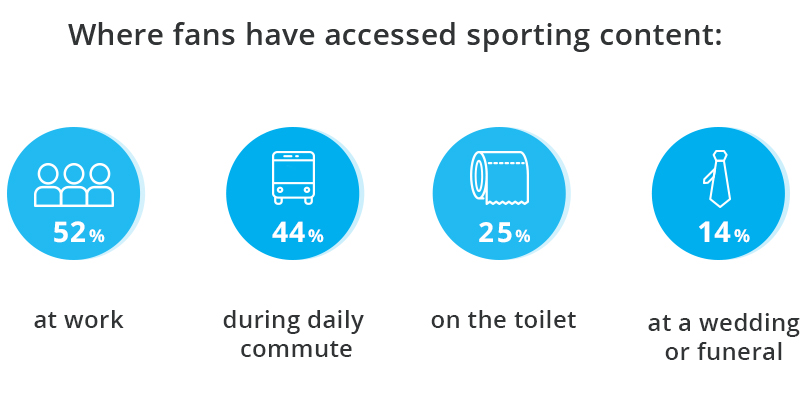
If you want to learn more about video’s impact on sports bodies and federations, explore our blog and case studies section, or simply contact us to discuss how you could benefit from utilizing our Tellyo platform.
Most of the videos mentioned in this article have been made using Tellyo Pro – our cloud-based platform for frequent and regular live content production. It enables you to ingest video streams and broadcast these to social channels and RTMP destinations, while also clipping live content into videos to post on social media.
If you’re looking to clip videos for social media, there are some new Tellyo automation features to consider, especially if you’re using Opta event metadata:
- Smart Clips, which automates video clip creation from live sports content.
- Auto Clip-to-Post that lets you fully-automate clip creation through to social messaging and social posting, all in one go.
Both are giving more power to editors in their mission to deliver quality sports content to audiences quickly and efficiently.
ITTF – from strength to strength with online video strategy
The International Table Tennis Federation (ITTF) is the governing body for 226 worldwide associations and oversees more than 120 international events. It is one of the largest sports federations in the world and has a proud history, having organised the World Table Tennis Championships since 1926.
Our partnership with the ITTF started back in 2017 and has since gone from strength to strength. Today, Tellyo is integral to the ITTF’s direct-to-fan video strategy, enabling the federation to stream matches and share clips
from tournaments previously difficult to access for fans across the globe.
Increased global streaming collaborations
Starting with one trial tournament in 2017, Tellyo now supports all of the ITTF’s major tours and championships. More recently, our platform has been used during regional events in remote locations within Fiji, Nigeria and India.
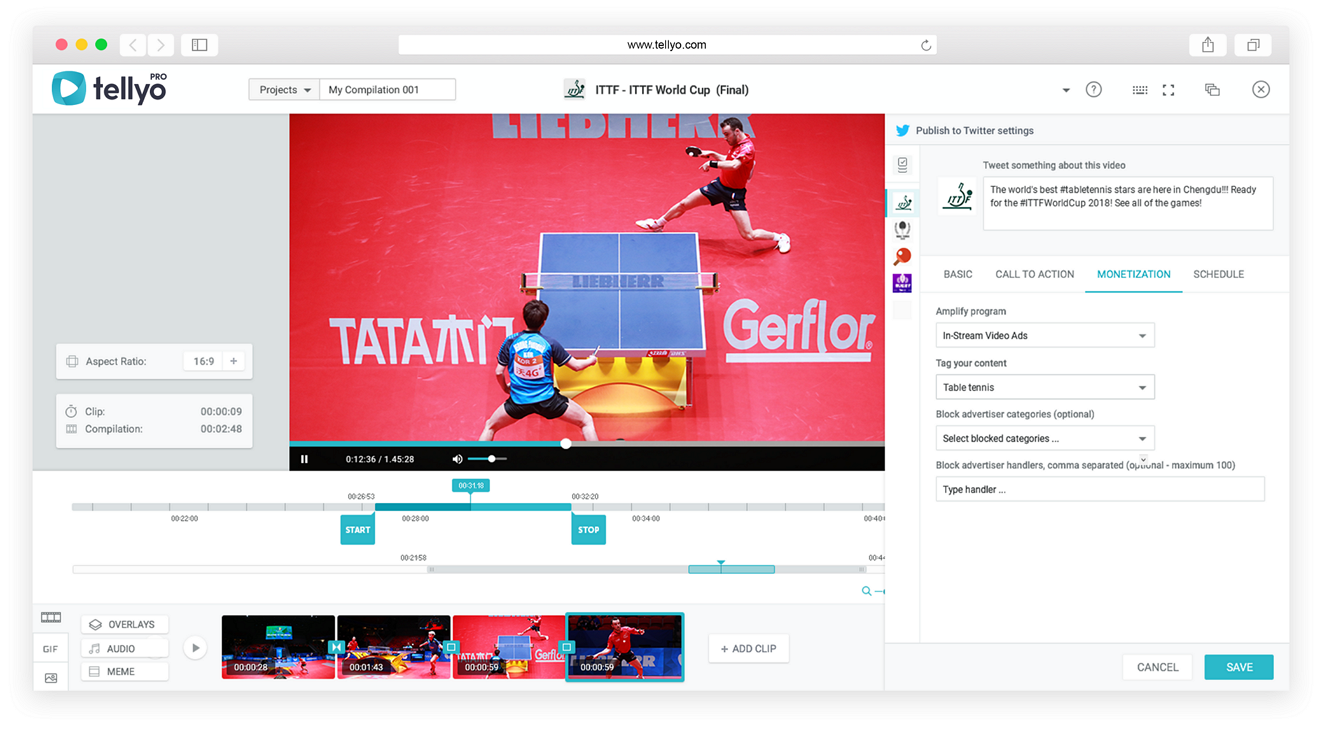
When working in remote locations, the ITTF rely on us to seamlessly deliver streamed content to global fans online. The key to our success is two-fold. Firstly, our platform’s infrastructure is capable of receiving signals from anywhere in the world, however remote, thanks to the network of servers we use. Secondly, we provide an extensive set of advanced tools to ITTF production teams, expertly meeting their various technical requirements.

Video clips further boosting engagement with the ITTF
With a greater number of tournaments being covered, the ITTF is seizing these opportunities to create more video clips for its social media channels. In turn, these clips help to drive viewers to its live stream and are having a hugely positive impact on overall engagement with the federation and table tennis online.
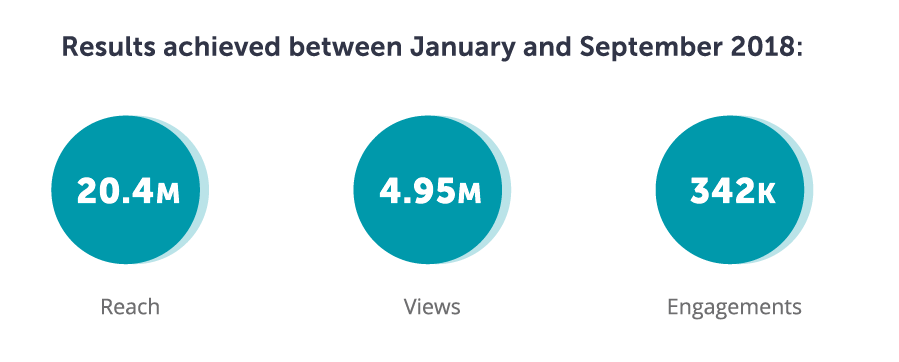
“I cannot imagine life without Tellyo. The platform is at the core of our social video strategy, helping us to showcase dynamic sports content from multiple ITTF tournaments online. All-in-all, thanks to Tellyo, we’re better able to entertain and excite our fans, dramatically improving our digital reach, video views and fan engagement levels across social media.”

How Facebook is creating its own sports streaming service and what we can all learn from it
In August 2017, when Facebook launched its video platform – Facebook Watch – it was a bold move to target the huge growth in online video consumption. Video is by far the most engaging content type[1]. It’s also relatively easy to monetise. So Facebook Watch is no great surprise, as it provides the social media giant with an on-demand service for longer-form video content and a space to promote its own video productions.
Facebook’s reasoning is actually very clear: People love watching video and Facebook wants to earn money from adverts shown in those videos. But, while Facebook has made it super easy to stream and publish videos on their platform – and with consumption still growing – there has never been one central place to find video content on the platform.
To find video content, Facebook users have to scroll down their feeds or use the search feature (which is far from useful when it comes to video search). Facebook has been aware of these limitations for some time – realising it’s not good enough if they want to be a serious player in the video market and why people still prefer to watch videos on YouTube or via on-demand services.
With Watch (released only in US so far), Facebook now has a go-to central area where users can easily find video content, which Facebook hopes will rival the likes of YouTube.
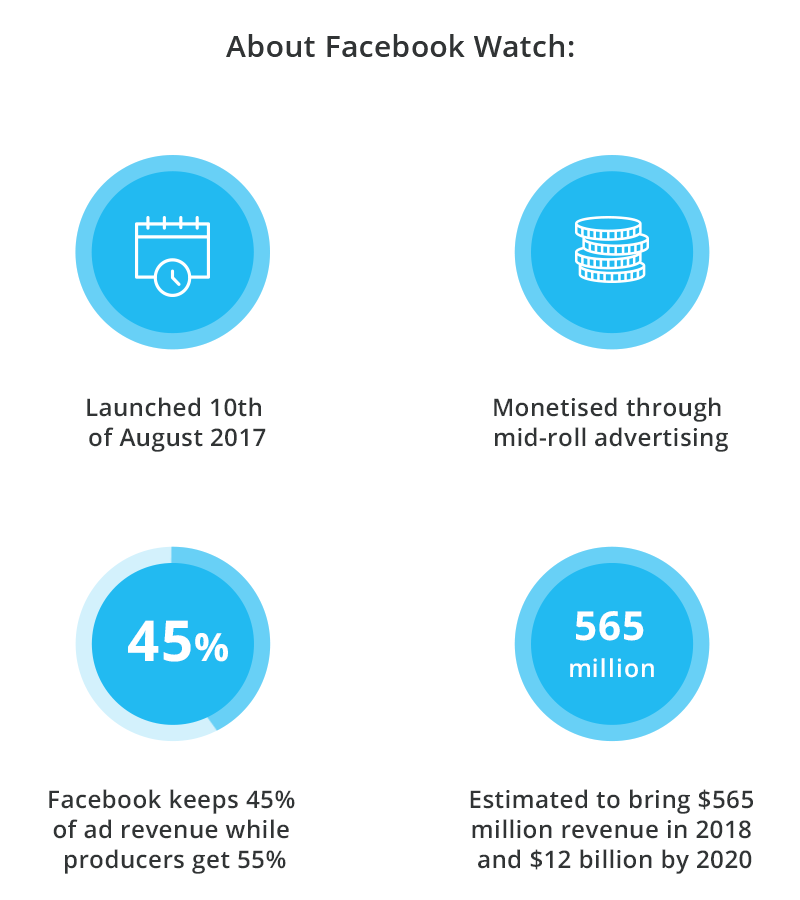
What’s inside Facebook Watch?
Video is not going to disappear from a user’s feed, but with Facebook Watch there will be more professional productions served in a better way. Watch’s menu is mostly a mix of comedy, documentaries, reality shows and documentary series dedicated to sports. The latter include shows like:
- Ball in the Family – dedicated to talented basketball players within Ball family and its notorious patriarch, LaVar. See how Ball’s family build their popularity with their video appearances here.
- Behind the Wall – showcasing NASCAR driver Bubba Wallace’s preparations for the Daytona 500 race.
- Bill Murray & Brian Doyle-Murray’s Extra Innings – which follows everyone’s favourite Bill Murray and his brother Brian Doyle-Murray, visiting Minor League ballparks where they explore small but strong communities dedicated to baseball.
- Fly Guys – which shows talented acrobats and their preparations to perform new stunts.
In the above, it’s easy to spot that Facebook Watch’s sports dedicated shows are not focused on mainstream events like playoffs etc. Instead they show what we used to call ‘behind the scenes’ in the cinema industry – for example, a look behind leagues like the NBA. Each episode of a series is often only 9 to 25 minutes long, just enough for online audiences.
Sports streaming – the future of Watch?
At the moment Facebook is relatively limited by the streaming rights secured by traditional broadcasters. If this doesn’t sound ambitious enough for you – it is still the first year of Facebook’s efforts to create their own TV on-demand service with sports at the fore.
However, Facebook is definitely positioning itself as an important player when it comes to buying streaming rights in the future. They already have lots of experience streaming live sports (deals with NBA, Liga MX, MLS, MLB) and now, with Watch, they have an on-demand platform on which to build for the future.
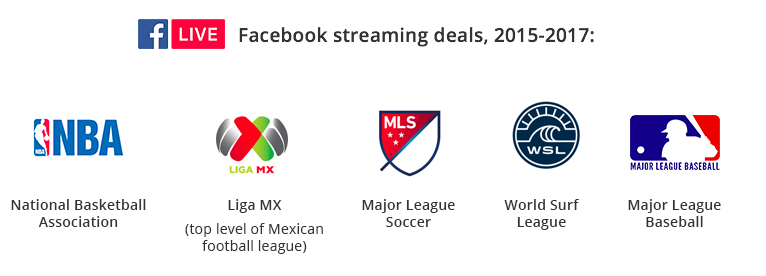
With such a sports streaming strategy in place, it seems there’s really nothing to stop Facebook from becoming the #1 digital sports streaming platform.
Ok, but I don’t have such resources!
Facebook’s plan to create an on-demand platform that will displace traditional TV in terms of sports streaming is ambitious. There are not many companies that could try this and succeed. But even smaller organisations like sport federations, leagues and associations can learn a few lessons.
Here are some tips for you:
First of all – start producing video. It’s the content of today and tomorrow, pretty affordable and will have a huge impact on your fanbase. No matter if you are producing five events per year or your league organises 200 games each season, video is more effective at creating online engagement than any other content type. Every day without video is your loss!
Next – include live video streaming in your marketing strategy. In the sports industry (and any other live-based industry to be honest) being here and now is everything. But you need to bear in mind that your fans aren’t always able to visit the stadium. If your organisation is international, you need to reach out to your global fans. Fans everywhere will want to see your content!
I bet you have plenty to offer your fans – so now tell your story! Use different content types and play with video. Create viral GIFs, best-play compilations, bloopers etc. Don’t limit yourself to the day of your event only – be active all the time, pump up the atmosphere surrounding important games and get involved in your fan community. See how big sports clubs are keeping their fans excited with creative video content here.
Once you start creating and showing your video content, remember that your audience will be watching it everywhere[2]. Literally! If you want to keep them entertained, make your videos mobile-friendly. Especially if you’re focusing on social media, as it’s consumed largely on mobiles. If you want to know more about mobile suited formats, click here.

With your own video content and a vibrant community built around your events, club, league or organisation you can finally monetise your productions. Involve your business partners and give them and their branding visibility in your videos. You can easily measure views and the reach of videos – extremely helpful data when negotiating advertising deals. You might create your own on-demand video platform or sell video subscriptions to allow fans around the world to see what you have to offer.
Even if you already have a streaming rights contract, there’s still a lot of stuff you can show – such as interviews with players, press conferences, training sessions or locker room insights. With some creative thinking there will be a plethora of things you can show to your audience. Just try to think outside the usual video-content box!
While not everyone has Facebook’s ambitions and resources, it’s important to realise that an effective video and live streaming strategy is possible to execute for organisations of all sizes and from a range of different industries. And, if you’re going to learn, then learn from the best! Meanwhile, why not consider one of our products – Tellyo Pro or Tellyo On Demand. See what suits your needs the best!
What makes real-time sports videos engaging?
It’s a good question to pose: what does make a real-time sports video engaging? Having worked with the International Table Tennis Federation (ITTF) for a year now, we feel we’ve developed a deeper understanding from what they’ve created and shared through our platform.
In this blog, we’ll take a look at some of the ITTF’s best moments of 2017 – a year that was truly amazing for the organisation, the players and the sport itself. Here at Tellyo, we’re extremely proud to work with the ITTF – the largest international sports federation in the world – to help them distribute such amazing events and historical moments across social media and to thousands of table tennis fans.
Here are their best, most epic video moments of 2017.
Did it hit?
Full of emotion and utterly unpredictable, sport has it all at times. Millimetres can separate players, with even the best referees sometimes struggling to make a call. Here’s what happened during the women’s finals of the ITTF World Cup.
Was the referee’s verdict right? Did the ball hit the table, or miss by millimetres? Watching the above video, we could argue all night long without any satisfactory conclusion; while the video’s comments section is also proof that fans love to watch this kind of content, to debate decisions and make their own call.

The Did it hit? video reached more than 6 million people, gained 1.3 million views and achieved more than 200 shares! And, just for the record, it was Zhu Yuling who won this amazing game!
The turning point
Every tournament features great personalities and the narrative of an underdog fighting their way to victory. Table tennis is no different. At the 2017 World Table Tennis Championships, the audience was treated to one of the most amazing games in the history of table tennis, ever.
Lin Gaoyuan had a five match points lead against Xu Xin, the world number three. More often than not, the winner would be obvious. But not this time, as Xu Xin kept pressing and won the game point by point, proving that table tennis is one of the most amazing and thrilling sports to watch.
Published on the ITTF’s Facebook page, it was table tennis’s equivalent of the 2005 Champions League Final between Liverpool and Milan. It reached more than 17 million, and achieved 1.7million views and 55,000 engagements, including over 7,000 shares!
Teenagers for the win
Born in 2003, Tomokazu Harimoto is table tennis’s teenage prodigy. Back in August 2017 he won the men’s singles title during ITTF World Tour in the Czech Republic. Aged 14, he became the youngest player ever to win the title, or any similar title, beating much older and more experienced players – something that doesn’t happen very often in professional sports.
Here’s one of the most popular ITTF videos from 2017: Harimoto winning against former Olympic bronze medallist, Jun Mizutani, who was two-times older than Harimoto at the time.
The video of Harimoto’s win reached 1.5 million and achieved almost 300,000 views on Facebook and Twitter.
What have we learned from these epic moments?
Online engagement is triggered by moments that represent the very essence of sport:
- The high emotion of being a sports fan
- Unusual turn of events or controversial decisions that sway matches
- The narrative of underdogs and youngsters defeating those considered to be masters
- Heroes like 14-year-old Harimoto who are quickly taken to people’s hearts
The ITTF videos shared above certainly resonated in some way with audiences – be it through emotion, or the narrative of an underdog or hero – and engagement levels rocketed as a result.
To experience even more epic moments, stay tuned for the upcoming 2018 ITTF Team World Cup being hosted in London.
Tellyo selected finalist SXSW accelerator pitch event
We are proud to share that we were selected as a finalist in the Sports and Performance Data Technologies category for the 10th annual SXSW Accelerator Pitch Event®.
The SXSW Accelerator is the marquee event of South by Southwest® (SXSW®) Conference & Festivals (March 9-18, 2018) Startup & Tech Sectors Track, where leading startups from around the world showcase some of the most impressive technology innovations to a panel of hand-picked judges and a live audience. Out of the more than 600 companies that applied to present at SXSW Accelerator, Tellyo was selected among the 50 finalists spanning 10 separate categories.
The two-day event will be held the first weekend of SXSW Conference & Festivals, Saturday, March 10 and Sunday, March 11, on the third floor of the Downtown Hilton Austin, Salon A/B. The Pitch Event will then culminate with the SXSW Accelerator Awards Ceremony on Sunday evening, March 11, where winning startups from each category and a Best in Show winner will be announced and honored.
The Accelerator will feature finalists across the following 10 categories: Augmented & Virtual Reality, Enterprise & Smart Data, Entertainment & Content, Health & Wearables, Hyper-Connected Communities, Payment & FinTech, Security & Privacy, Social & Culture, Sports & Performance Data, and Transportation.
Tellyo will present among four other companies in the Sports and Performance Data Technologies category on Sunday 11 March 2018.
Richard Collins, Tellyo CEO, said: “We’re excited to be shortlisted for the highly prestigious SXSW Accelerator Pitch Event and honored to be sharing the stage with other leading-edge technology innovators. At the event in March, we look forward to showcasing our cloud-based video production platform, and how it helps our customers to amplify live sports events and engage with fans more effectively online.”
Tellyo’s cloud-based video production platform gives sports broadcasters and rights holders the solutions they need to easily create engaging videos from live content, and share them to social and digital channels in real-time. The company has partnerships with the International Table Tennis Federation, Guinness PRO14 Rugby, broadcaster Polsat, sports television producer Sunset+Vine, extreme sports event organiser FISE, and British Cycling.
“For the past decade, we’ve had the honor of offering a platform to some of the most cutting-edge global technologies and innovations – allowing CEOs and developers to present their solutions to investors, potential partners and key targets,” said SXSW Accelerator Event Producer Chris Valentine. “Of those who’ve presented on stage, over 70% have gone on to receive funding in excess of nearly $4.63 billion. In addition, 16% of these companies went on to be acquired. We look forward to once again being a launching pad for startups to achieve some of their greatest successes. All of us with SXSW Accelerator are proud and impressed by the companies who are truly changing industries and changing the world.”
For more information about SXSW Accelerator and to view the complete list of finalists, visit: http://www.sxsw.com/interactive/awards/accelerator.
About SXSW
SXSW dedicates itself to helping creative people achieve their goals. Founded in 1987 in Austin, Texas, SXSW is best known for its conference and festivals that celebrate the convergence of the interactive, film, and music industries. The event, an essential destination for global professionals, features sessions, showcases, screenings, exhibitions, and a variety of networking opportunities. SXSW proves that the most unexpected discoveries happen when diverse topics and people come together. SXSW 2018 will take place March 9-18, 2018.
The future of sports fans: what should you expect?
What does the future look like for the sports industry and sports broadcasters? Who will be watching sports in the future, and how? An interesting report – The future of sports fans – by Performance Communications and Canvas8 provides a glimpse into what we can all expect.
On reading the report, one thing is for sure, if you don’t like change then you’re in for a white-knuckle ride. Here, I’m going to look at some of the report’s key points and stats, so fasten your seatbelt and prepare for a thrilling trip to the near future.
Huge changes are happening
The report makes it clear that we are on the edge of huge changes. In relation to sports fans – their habits, needs and the technologies they use are changing. To meet these new demands, the sports industry, content producers and broadcasters will need to shift current policies and practices, and be open to new ideas and ways of doing things.
Content is consumed everywhere… literally!
Timing in sports is so much more important than with any other TV produced content. You can watch your favourite movie every single year, or wait for the full season of your favourite series to watch in a row, but you can’t miss a game of your club.
You may find it interesting as well: 5 sports clubs keeping fans excited with creative video content.
The driver for much of this is the emotion that people attach to sports. Passion is high when there is only one game per week, with such intense emotions rising and falling for a couple of hours before and after. If it’s not a Champions League final or the Super Bowl, emotions will fade pretty quickly afterwards.
Almost all sport related content is transmitted live as events happen, with only 7% time shifted (for other TV produced content one third is not live). This is why sports fans are so eager to use mobile devices to watch sports – they’re not forced to sit at home or in the pub to see and follow live events any more. Instead, they’re using smartphones and tablets to follow live results, catch replays or actual games thanks to mobile-friendly sports services. For example, the American leader in the TV-sports industry – ESPN – often has two-thirds of its audience visiting ESPN services via a mobile only.
For 73% of fans it’s important to be able to access sports whenever and from wherever they want, as the below graphic shows:
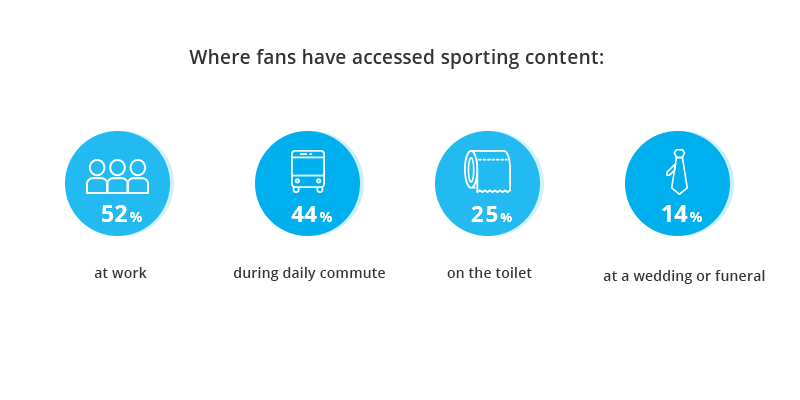
Well, whoever is without sin, cast the first stone!
[bctt tweet=”75% of people taking part in the research have watched a replay on their phone at a live venue!” username=”TellyoTV”]
Pro tip for broadcasters: Let the audience consume your content in the manner they choose and at the most convenient time for them.
Pre and after game content is crucial
Live sports broadcasts are ephemeral – they come and go at specific times. However, sports audiences are very keen to watch content before an event and after it. The day before a game or event, fan consumption of sport related videos increases by 75%, as the audience seeks information about their team and the game itself.
This represents a great opportunity for rights holders and broadcasters alike – to improve your social media presence and reach many more fans with timely content.
Pro tip for broadcasters: Plan events very carefully – don’t forget to produce some pre-event warm-up videos and post-event summaries.
The audience is tech savvy
The quality and attractiveness of content is extremely important for viewers. They want to see different types of content, including live streams, short clips, compilations, highlights etc. However, all the content you offer has to be high quality. For example, 50% of fans say that interactive slow-motion replays would improve the fan experience, and 3 in 5 want to have the ability to choose different camera angles.
While those technologies are yet to come, these responses provide more evidence that sports audiences are both tech savvy and demanding when it comes to technology’s capabilities. Also, they want to influence the way they consume videos now and in the future.
Pro tip for broadcasters: Not every breakthrough technology is going to became standard – do you remember Google Glasses? But the pace of technological changes rapid and you should always keep an eye on interesting trends. Your audience is hungry for them!
Make piracy useless
Web piracy is a huge problem for many industries, including web streaming and broadcasting businesses.
In 2015, the fight between boxing superstars Floyd Mayweather Jr. and Manny Pacquiao was streamed to about 10,000 users via Periscope, for free.
Piracy can be as simple as pointing your smartphone at a TV screen and hitting ‘go live’. And there will be thousands of people happy to watch for free, despite the poor quality and obvious piracy.

Is there a clever way to stop such piracy? While the law is on the side of rights holders, there is no silver bullet to prevent piracy. However, there are dependable things that broadcasters can do to minimise losses.
The most obvious would be to provide an attractive and affordable offer to potential viewers. Whether subscription based or pay per view, if your service is easy to access and affordable there’s a great chance that a potential pirate will choose a high-quality and convenient but paid solution. But only if that viewer is able to see the content in the way they want!
Pro tip for broadcasters: The best way to get rid of piracy is to make it obsolete. While there are regions in the world where you can’t compete with piracy, it’s important to keep your offer attractive and customised.
Keep your eyes open
Soccer, American football, basketball and cricket might be the most popular sports, but many broadcasters might be missing something that statisticians and marketers are calling ‘long tail’.
What is long tail? In relation to sports it means that there might be a number of less popular sports that when combined have a similar or perhaps an even bigger value than mainstream sports. While it would be extremely difficult to doubt the popularity of the world’s leading sports, it is worth checking what’s going on in esports, women’s soccer leagues or newer sports that are gaining popularity. It looks like the underdogs will have their day, eventually.
This is what sports fans are thinking in terms of mainstream and less popular sports:
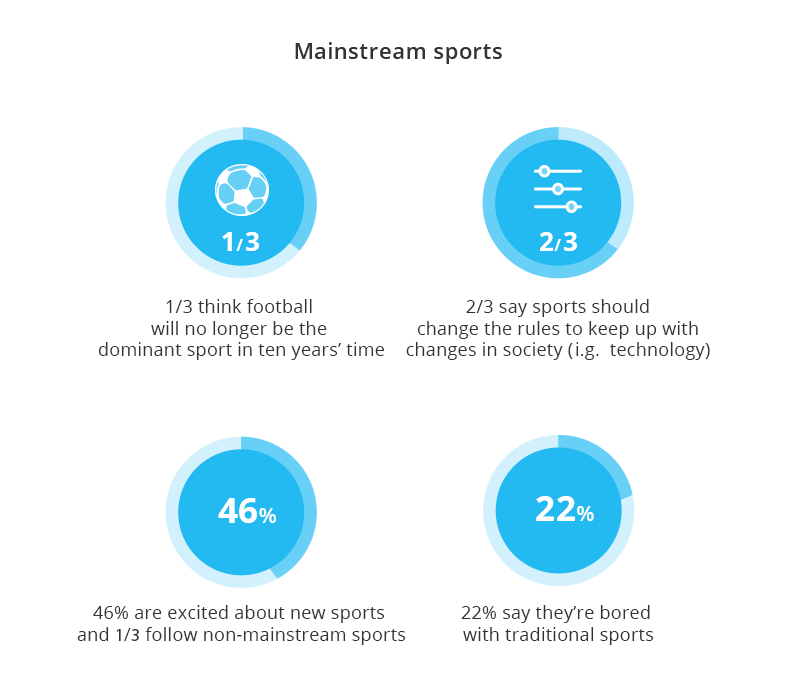
What seems pretty logical is that the home for non-mainstream sports is often on digital media platforms:
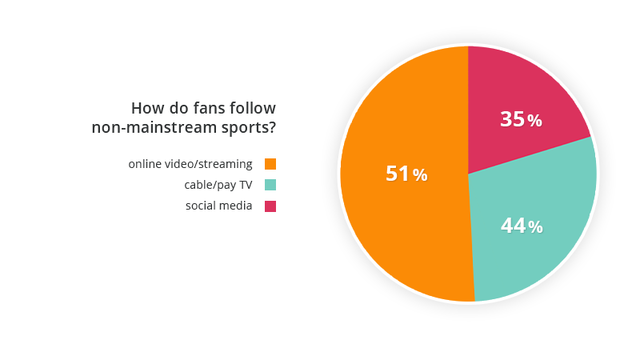
Pro tip for broadcasters: Football, soccer and basketball are leaders, while there are hundreds of ‘long tail’ sports with engaged audiences often following online and via social media. Combining these sports together could bring interesting results.
Change is the only constant
While there is not a universal strategy for sports broadcasters who are entering the social media and online world, one thing is for sure… Being immune to the changes that are occurring now is the best recipe for disaster. If you want to succeed, stay open minded and be ready for change.
You can download the report here.
Your essential read if you’ve ever wondered how to make traditional TV cool again!
In the US, adults are spending more and more time with different kinds of digital media[1], while their attention is also shifting from traditional TV to PCs, and smartphones and tablets connected to the web.
What’s interesting is that while there is an enormous variety of traditionally broadcast TV channels to choose from (a monthly average of 206 channels according to Nielsen research), US adults only actively watch 20 of them[2]. In other Nielsen data for US adults, while TV still rules people are using a broader range of devices for home entertainment, with apps and the web now hot on the heels of TV. The total time spent on other devices now outweighs time spent watching traditional TV.
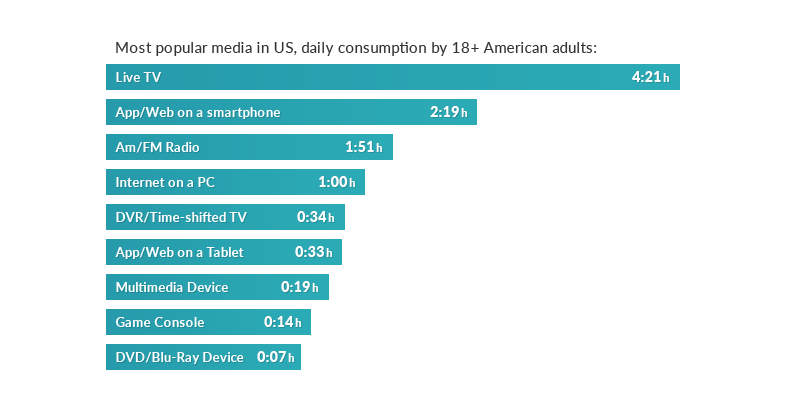
If you look at the behaviour of younger viewers in particular, what’s evident is that Generation Z (12-20 year olds) consume the smallest amount of traditional TV, either when live or time shifted/recorded. Arguably, this is the effect of a new and younger audience becoming bored (or simply not accustomed to) traditional TV’s linear approach, which might be a challenging argument to accept if you work in broadcast TV.
To help you to understand, let’s look at this analogy. Nowadays, traditional TV is like a middle-aged guy trying to gain popularity on Snapchat – the technology feels the same, the rules are clear, but somehow it simply doesn’t work for him. What he says and does is simply not attractive enough for the audience on that platform. (Believe me, I feel like this guy at times as I don’t always understand the buzz surrounding Snapchat.)
Back in the broadcasting world, you may be more than conscious that new ways of consuming media are coming. You might feel they’re already here. Yet, with huge resources, varied schedules and all the broadcasting technology at your disposal, perhaps you’re still left wondering why traditional TV isn’t as attractive as it was? Perhaps you can’t quite put your finger on why this is the case.
Let’s take a closer look at some of the opportunities and threats below.
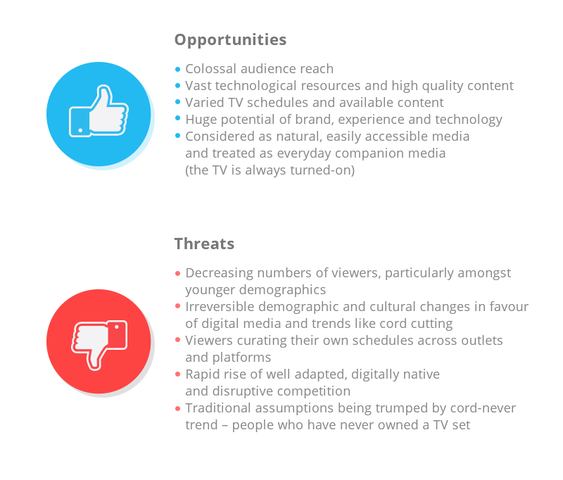
What’s common amongst the above threats is the impact of the internet and the smartphone. Viewers now have more flexibility – they can watch and interact with digital, web TV and OTTs in any manner they like, where and when they want, and on the device of their choosing.
Why should viewers miss the ol’ set-top box? So, is this the end of linear TV as we know it? It’s too early to jump to this kind of conclusion. For sure, there are now many more options to traditional TV and improvements that linear broadcasters should make to stay in the game.
Let’s dive in and check out six ways you can sharpen your focus to stay alive in this fast-paced, digital-first world.
- Make the web your friend and ally
- Use your TV brand as leverage
- Your experience is your advantage
- Retain your loyal viewers
- Work across platforms
- Conversations – it takes (at least) two to tango!
First things first, if you haven’t done so already, make your brand more visible online by expanding your social media presence. Take time to reconsider your options, making an audit of your efforts to date to identify what’s worked and what hasn’t.
When relaunching your social media presence, have a video content strategy in place that puts you in a position to start streaming and producing videos for social channels. Streams and social videos make for highly engaging web content and, as a broadcaster, you are ideally placed to create a constant stream of such content. To do so, choose social video production tools and platforms that will fit your needs, and ones that will enable you to stream and produce videos from live content and any archival content you want to use.

Live streams and videos are undoubtedly the most engaging types of content. When checking Facebook streaming results for one of our Tellyo clients, we learned that it is possible to create up to 400 interactions per 1,000 fans with live video, while images were able to reach only 6 interactions per 1,000. For further interesting stats, check out the case studies section on our website.
Having a strong and recognisable brand is unbelievably helpful online – it will help you to stand out. If your logo is well known, you should remember to place it on your video content, so that when this spreads around the internet you get the brand recognition you deserve. With a little bit of luck, many viewers will trace your quality content back to your channel or Facebook page.
Being experienced with video production and everything broadcasting related is a huge advantage over your competitors. Being able to create TV-grade video content, while having an experienced team and professional equipment are all strong assets. However, these assets aren’t enough to be successful on the web and in the social media, but they will help a lot. You can always talk to us here at Tellyo about how to combine your experience with an advanced, social video production platform such as ours.
Have you ever heard of the Pareto principle[4]? Better known as the 80/20 rule which states that 80% of the effects come from 20% of the causes. Translating this into broadcast language – it means that 20% of your audience is responsible for 80% of your views. Therefore, if you want to be successful in social media, play to your core audience. Let them know that soon they will be able to watch their favourite shows and events via other media as well.
Remember that social media isn’t monolithic – it’s decentralised and each platform has its own properties. You shouldn’t copy and paste your strategy from one channel to another. For example, if you decide to stream content then use YouTube, Facebook or Twitter, but only YouTube will be a good place as a platform to host clips for a longer period. Facebook will give you a big audience and visibility initially, but people will not find your videos once they vanish from timelines.
Your audience has a voice, and it will use it. In comments, emails and chats, they will use each possible channel to give you their opinion about your content. And that’s a good thing – a gold mine of interactions and engagement to treasure. You should work hard to maintain these conversations. Be active: answer questions and ask for opinions.
It’s too early to abandon ship
Traditional, linear TV still has a lot to offer audiences. But the TV landscape in the next 5-10 years will be dramatically different to what we have now.
In the meantime, there is likely to be many more advances and disruptive changes. Now is your chance to decide whether you want to be part of it or not.














